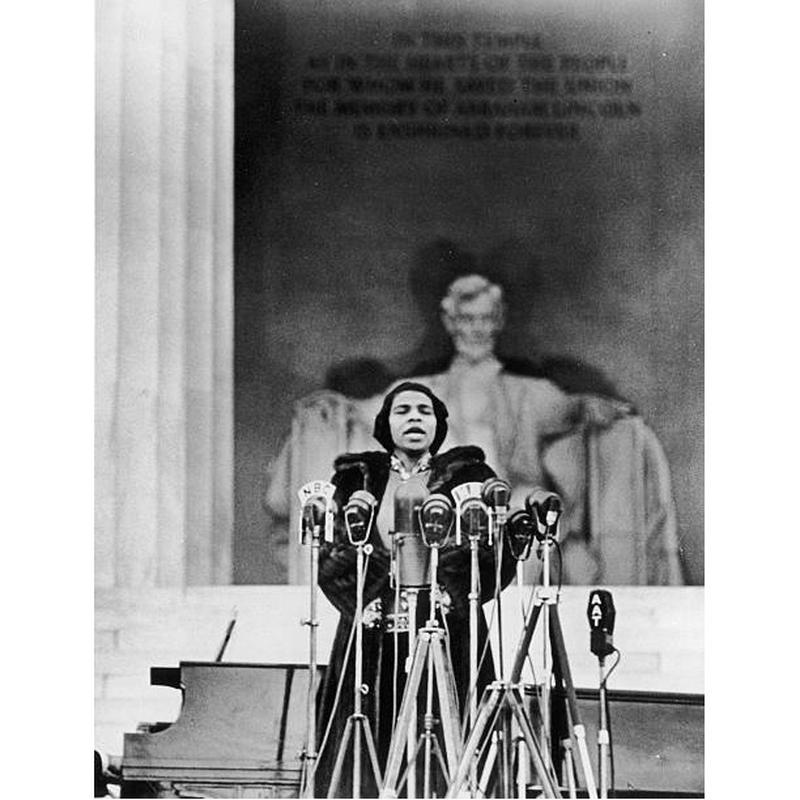Marian Anderson’s Historic Concert
By | December 12, 2022

Long before Martin Luther King Jr. gave his “I Have A Dream” speech in front of the Lincoln Memorial, Marian Anderson, the then 42-year-old contralto sang to an audience of 75,000. In this iconic photo, Anderson looks regal with the Lincoln statue behind her as she performs this historic concert, wearing a mink coat to protect against the wind; the mink coat which has a lining embroidered with gold threads in a paisley pattern, and the monogrammed initials MA is now in the Anacostia Community Museum in Washington, where it is in an archival box in cold storage, protected with acid free tissue to preserve its shape.
The Largest Audience She Performed In Front Of
The performance, on April 9, 1939, was before the largest audience she had been in front of, and it was just Anderson and a pianist. How she got here was a story of segregation and racism, but the ultimate location of the concert was appropriate. According to the NBC Blue Network announcer, she was singing in this particular venue “because she was unable to get an auditorium to accommodate the tremendous audience that wishes to hear her,” but this claim wasn’t true.

She Needed A Space To Accommodate Crowds
Anderson was already a renowned singer before the concert, as she was probably the first American American to perform at New York’s Metropolitan Opera. As part of their concert series, Howard University had invited her to sing in Washington, but they required a place that could accommodate large crowds. They were looking to use Constitution Hall; however, the Daughters of the American Revolution owned it, and they refused to allow her to use it. Their reason: every DAR contract had a white-artist-only clause.
Constitution Hall Was Segregated
In 1939, Constitution Hall was segregated like much of the nation, and the black audience was only allowed to sit in a small section of the balcony. Black performers had been allowed to appear in the Hall early on, but when a singer refused to perform in the segregated auditorium, the DAR refused to allow any other black performers.
The Lincoln Memorial Was The Second Choice
At the time, first lady Eleanor Roosevelt had been a member of the DAR. In reaction, she resigned from the organization and wrote about the DAR’s stance in her weekly column, “My Day.” This had no effect on the DAR, but Walter White, the secretary of the NAACP at the time, was able to come up with a solution: to have the concert at the Lincoln Memorial, a national monument. Because of its status as a monument, the Secretary of the Interior, Harold Ickes, had the responsibility for the logistics of the concert, and he was the one who led Anderson onto the stage, which was built over the steps of the Memorial. He introduced her, saying that “Genius draws no color line.” Anderson was not a civil rights activist, but she believed that prejudice would disappear as long as she behaved and performed with dignity.

The Concert
She began the concert with “My Country, ‘Tis of Thee.” However, she did make a change to the song: instead of singing “of thee I sing,” she sang “to thee we sing.” She had a reason for this change, which she explained years after the concert. As Anderson said “we cannot live alone,” and she recognized that the moment was made possible because of “many people who we will never know.” She followed “My Country ‘Tis of Thee with an aria from La favorite by Gaetano Donizetti, and Schubert’s “Ave Maria.” She performed for 25 minutes, and concluded with “Gospel Train,” “Trampin’,” and “My Soul is Anchored in the Lord,” three spirituals.
Eventually She Sang At Constitution Hall
Anderson, who lived to be 96, did not seem to be angry and bitter about the DAR’s refusal to allow her perform. And yes, she eventually did sing at Constitution Hall after the DAR apologized and changed their rules.